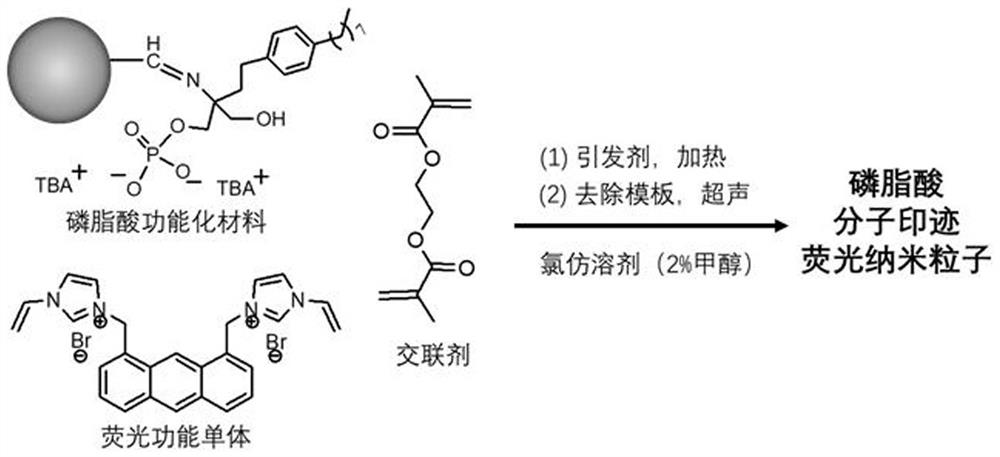A kind of phosphatidic acid molecularly imprinted fluorescent nanoparticle and its preparation method
A fluorescent nanometer and molecular imprinting technology, applied in the field of analytical chemistry, can solve the problems of lack of specificity of molecularly imprinted polymers, residues of template molecules, and low utilization of templates, so as to improve selectivity and specificity, high specificity, and improve efficiency effect
- Summary
- Abstract
- Description
- Claims
- Application Information
AI Technical Summary
Problems solved by technology
Method used
Image
Examples
Embodiment 1
[0036] Preparation of aldehyde-modified silica nanoparticles (SN-CHO), see figure 1 ,Specific steps are as follows:
[0037] Step 1: First, ammonia solution (25 wt.%, 30.4 mL), ethanol (200 mL), and water (306 mL) were mixed in a 1 L round bottom flask and stirred at 600 rpm; subsequently, ortho-silicon was added A mixture of ethyl acetate (45.6 mL) and ethanol (456 mL) was stirred at room temperature for 8 hours; finally, silica nanoparticles were collected by centrifugation (10,000 rpm, 10 min) and washed with ethanol at least three times at room temperature After drying under vacuum for 24 h, silica nanoparticles (SN) were obtained with a yield of 37%.
[0038] Step 2: Disperse SN (14 g) into anhydrous toluene (280 mL) by magnetic stirring in a 500 mL three-necked round bottom flask; then, add 3-aminopropyltriethoxysilane ( APTES, 2.37 g, 10.7 mmol), and refluxed at an oil bath temperature of 130 °C for 12 h; after the reaction was completed, the mixture was cooled to ro...
Embodiment 2
[0041] Preparation of fingolimod phosphatidic acid bis(tetrabutylammonium) salt functionalized silica nanoparticles (named SN-FP(2TBA)), see figure 2 , the specific preparation process is as follows:
[0042] The template molecule fingolimod phosphatidic acid (FP) (29 mg, 0.075 mol) was added to a dispersion of SN-CHO (0.25 g) in 2 mL of phosphate (10 mM, pH 7.4) under magnetic stirring at room temperature After 24 h of reaction, the nanoparticles were collected by centrifugation (10,000 rpm, 10 min), washed three times with phosphate buffer, pure water, and methanol, respectively, and then the nanoparticles were vacuum-dried at room temperature to obtain FP-modified silica nanoparticles. (SN-FP). Then 0.25 g SN-FP was dispersed in methanol (2 mL), tetrabutylammonium hydroxide (TBA-OH, 0.3 mmol) was added, and the reaction was stirred at room temperature for 12 h, then washed with methanol three times, and vacuum dried at room temperature to obtain the template The molecula...
Embodiment 3
[0044] Fingolimod phosphatidic acid molecularly imprinted fluorescent nanoparticles (poly(IMID-EGDMA)-MIP) and their control polymers (poly(IMID-EGDMA)-NIP) were prepared.
[0045] Preparation of fingolimod phosphatidic acid molecularly imprinted fluorescent nanoparticles (poly(IMID-EGDMA)-MIP), such as image 3 As shown, the specific preparation process is as follows:
[0046] (1) SN-FP(2TBA) (50 mg), fluorescent functional monomer 1,8-anthracene-bis(3-vinyl-1H-imidazole) dibromide (IMID) (5.7 mg, 10.3 μmol), The cross-linker ethylene glycol bis(methacrylate) (EGDMA) (65 μL, 344 μmol) and the initiator azobisisoheptanenitrile (ABDV) (5 mg, 20.1 μmol) were dissolved in 10 mL of chloroform and mixed with 0.2 mL of methanol in liquid.
[0047] The synthetic method of the fluorescent functional monomer 1,8-anthracene-bis(3-vinyl-1H-imidazole) dibromide (IMID) is as follows: First, 1,8-dibromoanthracene (1.09 g, 2.0 mmol) It was dissolved in 25 mL of acetonitrile, then N-vinyli...
PUM
 Login to View More
Login to View More Abstract
Description
Claims
Application Information
 Login to View More
Login to View More - R&D Engineer
- R&D Manager
- IP Professional
- Industry Leading Data Capabilities
- Powerful AI technology
- Patent DNA Extraction
Browse by: Latest US Patents, China's latest patents, Technical Efficacy Thesaurus, Application Domain, Technology Topic, Popular Technical Reports.
© 2024 PatSnap. All rights reserved.Legal|Privacy policy|Modern Slavery Act Transparency Statement|Sitemap|About US| Contact US: help@patsnap.com










